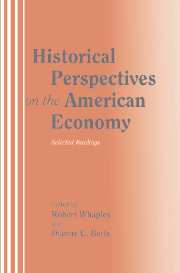Book contents
- Frontmatter
- Contents
- Acknowledgments
- Introduction to students
- Introduction to instructors
- Contributors
- I Introduction
- II Colonial and early national economy
- III Slavery and servitude
- IV The South since the Civil War
- V The rise of American industrial might
- VI Populism
- VII Women in the economy
- VIII The Great Depression
- Appendix: Basics of regression
- Glossary
- Name index
- Subject index
V - The rise of American industrial might
Published online by Cambridge University Press: 05 June 2012
- Frontmatter
- Contents
- Acknowledgments
- Introduction to students
- Introduction to instructors
- Contributors
- I Introduction
- II Colonial and early national economy
- III Slavery and servitude
- IV The South since the Civil War
- V The rise of American industrial might
- VI Populism
- VII Women in the economy
- VIII The Great Depression
- Appendix: Basics of regression
- Glossary
- Name index
- Subject index
Summary
“The railroads: The first modern business enterprises, 1850s–1860s”
by Alfred D. Chandler, Jr.Alfred Chandler's writings have “established the framework in which most scholars now understand the history of big business” (Porter, 1992, 125). This essay is part of Chandler's Pulitzer and Bancroft Prize-winning volume The Visible Hand: The Managerial Revolution in American Business (1977). In The Visible Hand, Chandler first describes traditional enterprise, under which most economic coordination is implicitly carried out by the “invisible hand” of the market. He then delineates the advantages of the “visible hand” of management in creating economies of scale within large firms and chronicles the rise of big business, beginning with the railroads.
According to Chandler, a modern business enterprise has many distinct operating units and is managed by a hierarchy of salaried managers. He advances seven propositions about the development of modern business enterprises (pp. 6–10):
They replaced small traditional enterprise when administrative coordination permitted greater productivity, lower costs, and higher profits than coordination by market mechanisms.
The advantages of internalizing the activities of many business units within a single enterprise could not be realized until a managerial hierarchy had been created.
Modern business enterprises arose when the volume of economic activities reached a level that made administrative coordination more efficient and profitable than market coordination.
Once a managerial hierarchy had been successfully established, the hierarchy itself became a source of permanence, power, and continued growth.
The careers of the salaried managers who directed these enterprises became increasingly technical and professional.
[…]
- Type
- Chapter
- Information
- Historical Perspectives on the American EconomySelected Readings, pp. 315 - 316Publisher: Cambridge University PressPrint publication year: 1995

